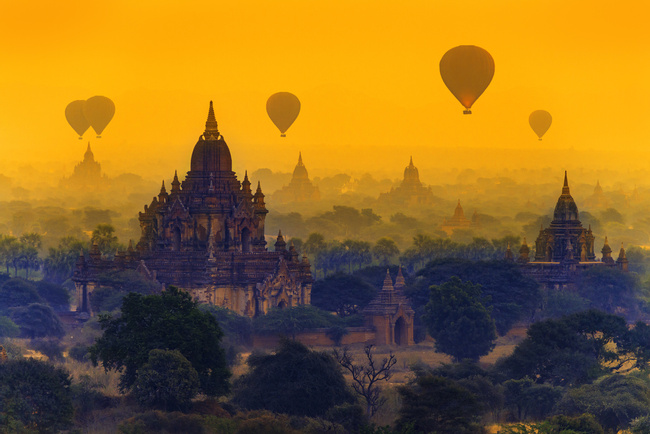- Travel Guides
Myanmar Culture
What is this red stuff on the ground? What should I wear to a temple? Why do so many people’s names start with “U”? Outside of religious practices, Myanmar has a few cultural practices that are particular to Southeast Asia. Read on to learn what to expect as your stroll the streets of Myanmar.

Religious Rituals
For most of the Myanmar society, everything in life revolves around their country's most widespread religion, Theravada Buddhism. Year round, the country's pagodas, temples, and monasteries glisten with gold leaf and are kept in pristine condition. Each morning a procession of monks walk barefoot through the streets to collect donations of rice and fruit from the locals. During religious festivals, places like Shwedagon Pagoda are packed with pilgrims.
Keep in mind that modest dress is the norm in Myanmar. When you visit a religious site, make sure to dress in a somber manner. It’s not unheard of for visitors to be asked to done a traditional longyi skirt if monks deem them to be underdressed.
Names in Myanmar
Myanmar does not use surnames or family names the way westerners do. Burmese people typically have more than one name, and part of the name usually reflects the day when they were born. Family members do not necessarily have any names in common.
It’s also not uncommon to change names. People who have bad luck will sometimes change their name in hopes of changing their fortune.
There are 4 standard prefixes: U, Ko, Maung, Ma, and Daw.
• U — “Sir” or “Mister.” This prefix is used for a man with a well-established career, or a man of importance. • Ko — Older brother • Maung — Little brother • Ma — Little sister • Daw — Aunt
Keep in mind that “Maung” and “Ma” are also popular first names.
Theater and Dance
Theatrics are a huge part of Burmese culture. Elaborate dances, costumes, and puppet shows are part of most major holidays and festivals.
Read about marionettes in our Handicrafts article.
Betelnut
On the sidewalks and streets throughout Myanmar, you will likely see crimson stains on the ground. Don’t worry, it’s not blood — just betelnut juice.
Betelnut has a similar effect as caffeine, and stains teeth red. Chewers store betelnut between their gum and cheek, much like chewing tobacco, and then spit as they chew. It’s most popular among blue-collar workers — for instance, taxi drivers are known to use betelnut as a way to stay awake during long shifts.
Betelnut is made from diced areca nuts and sprinkles of tobacco wrapped up in a betel leaf. This small parcel, known as a quid, is made at countless street stands throughout Myanmar.
Thanaka
Women in Myanmar cover their faces and arms in a beige paint called thanaka. Thanaka is a natural sun protection made from the bark of the thanaka tree. In markets, you’ll vendors grinding up the bark and applying the paste to their customers.
Longyi
The longyi is a traditional type of Burmese skirt worn by both men and women. It is a length of fabric sewn into an easy-to-wear cylinder.
Lapet
Lapet are pickled tealeaves. They are a common addition to salads, and have ceremonial importance as well. Boys who have been chosen to enter the monastery are gifted with small packets of lapet.
Indigenous Groups
Myanmar has a complex political history in part because of the many different ethnic groups and cultures that live within its borders.
Familiarize yourself with the many different groups throughout its regions.
• Shan is the largest minority group in Myanmar. They have close cultural ties with Thailand.
• The Mon people also have Thai roots, and they are subdivided into three different groups — the Padaungs, the Palaungs, and the Inthas. All of these groups live in the Shan State.
• The Padaung are known for their tradition of wearing golden rings around their necks, adding new rings to help stretch their necks to eye-catching lengths.
• Inthas live near Inle Lake
• Palaungs are known for their colorful dress and tea crops.
• Karens are also in Shan, and they are one of the few predominantly Christian groups in Myanmar.
• Kachins live in Myanmar’s northern mountains.
• Chins and the Arakanese live to the south.
It's more than just having a good time or visiting beautiful places (although that's absolutely a part of it!), it's about being part of a unique experience that stays with you.



